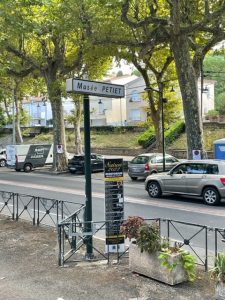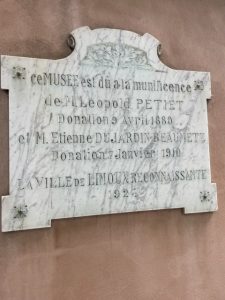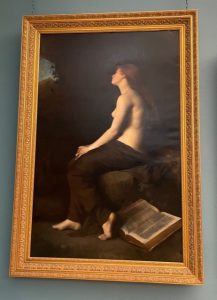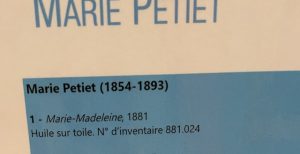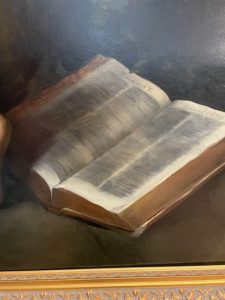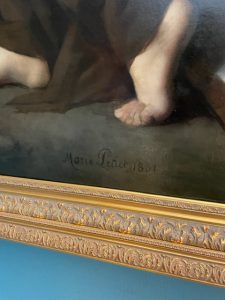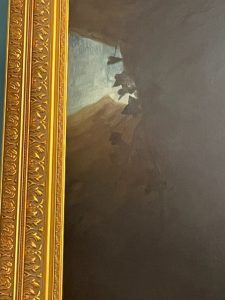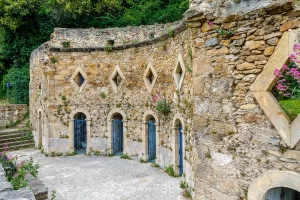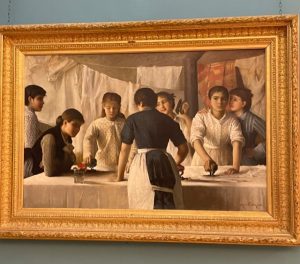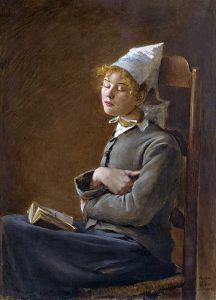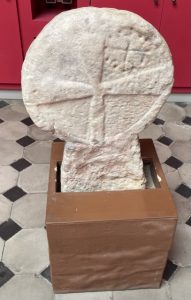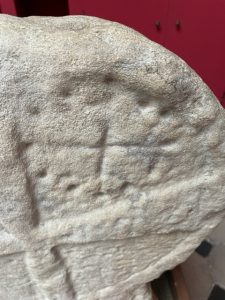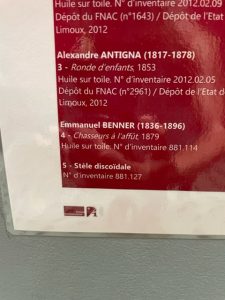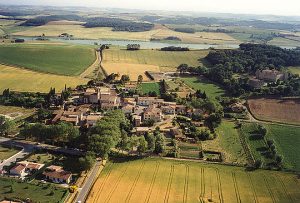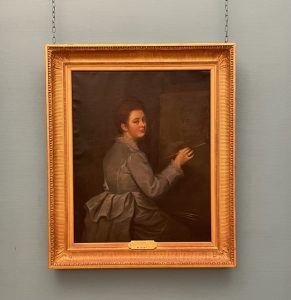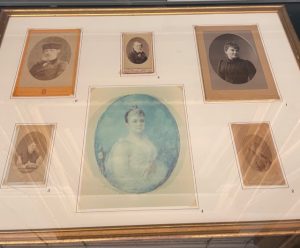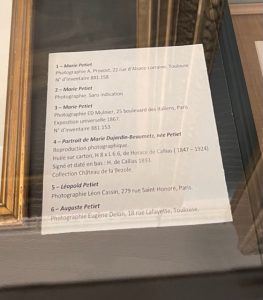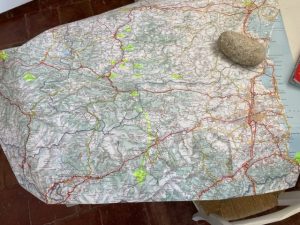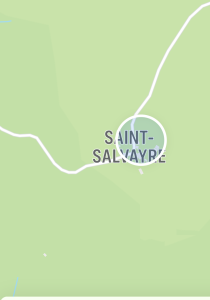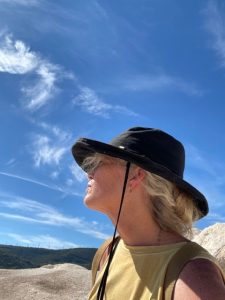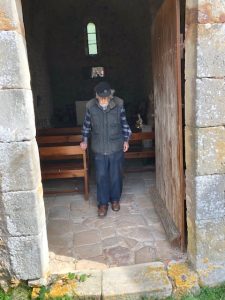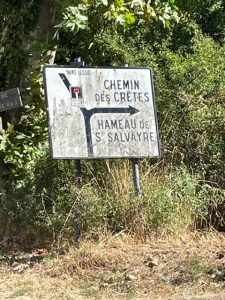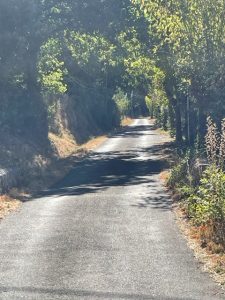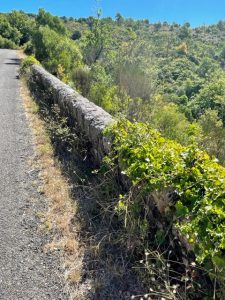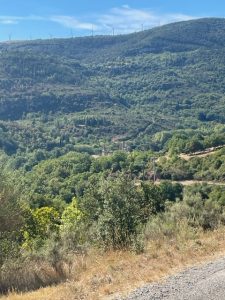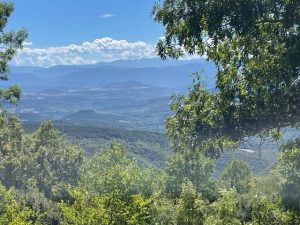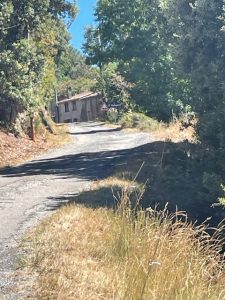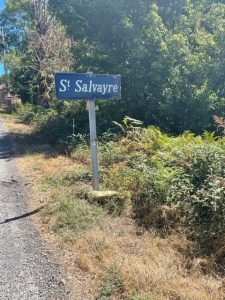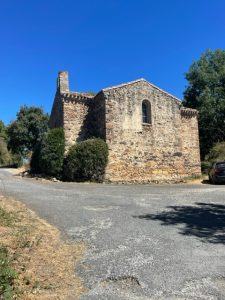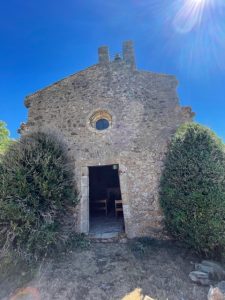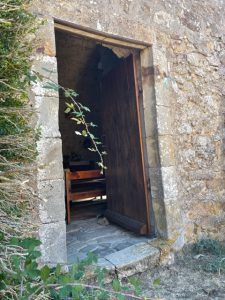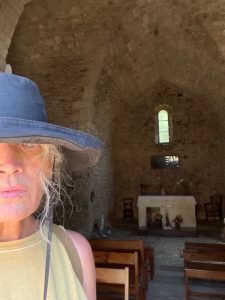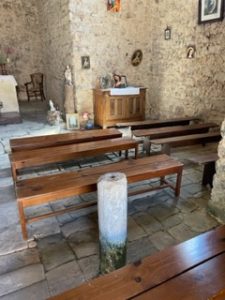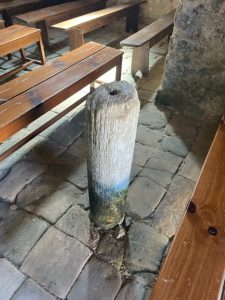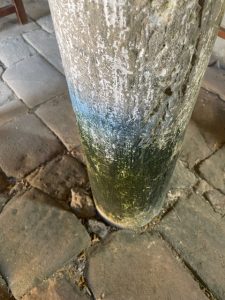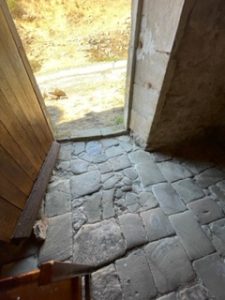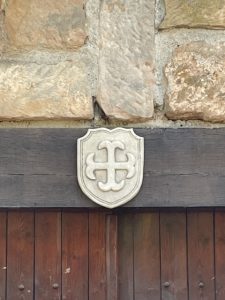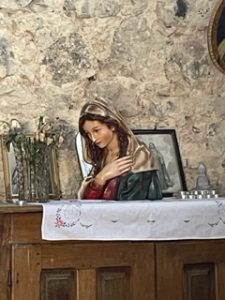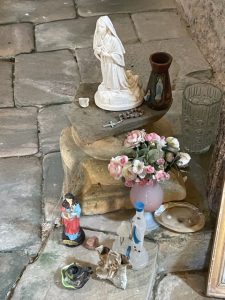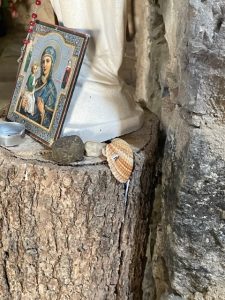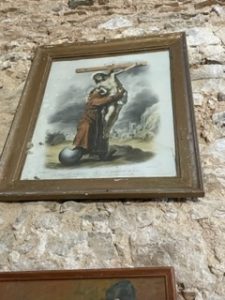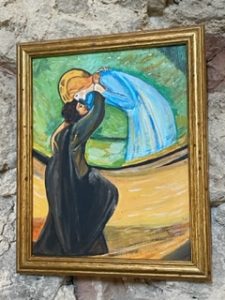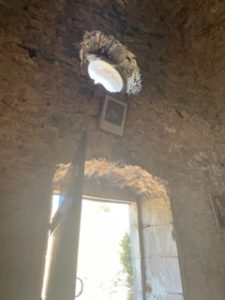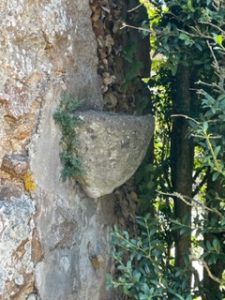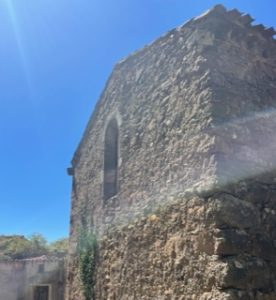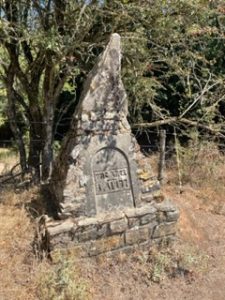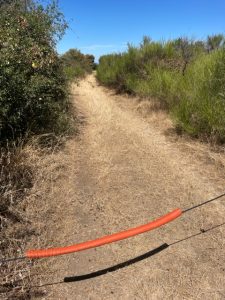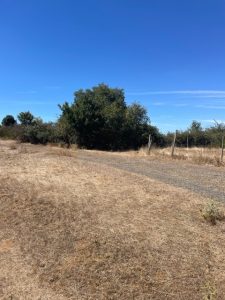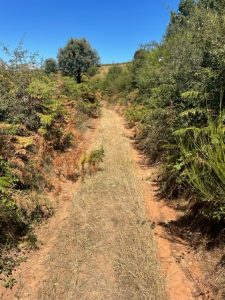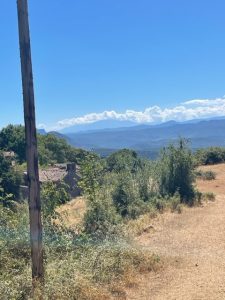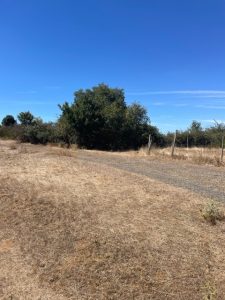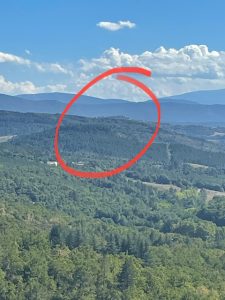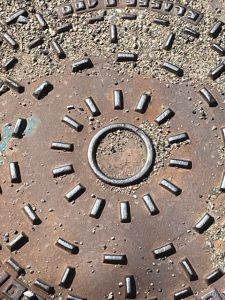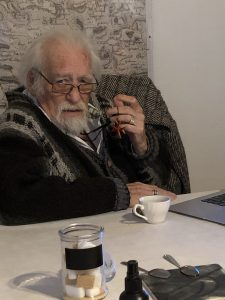Rennes-les-Bains
Dayle in Limoux – Day #63
September 6, 2022Crazy discovery today in Limoux at a lovely little museum called musée Petiet de Limoux.
Marie was born and lived in Limoux until her early 30’s. It was after her dad died, also an artist, that she married and moved close to Paris. The discovery? Finding a Mary Magdalene painting! I think I actually exhaled an audible gasp.
Marie was a beautiful painter. So talented. Look at her detail, and use of light & dark.
The photo on the right you can see she signed this painting with the year, 1881. She has positioned Mariam in a cave here in the Languedoc region, and she’s gazing at a hill in the distance.
Could it be Rennes-les-Chateau, where the church of Mary Magdalen is located, or Le Bézu…maybe Bugarach? Trying to research and learn more. Many caves in this area, the Languedoc region, with theories and stories enveloping them. I have been to one where it is believed Mary Magdalene visited, near Rennes-les-Bains. She reportedly administered baptisms in the river there, River Sals. There are healing waters in that little ancient village, which at one time were frequented by Romans.
Many authors and artists convene and live there now, as well as a small, private group of people who still practice the Cathar ways. This is where Sir Henry Lincoln lived. [Holy Blood, Holy Grail]
MARIE PETIET
FRENCH, 1854–1893
‘Marie Petiet began her artistic training with her father and uncle, who were wealthy landowners and amateur painters. Between 1877 and 1883 she studied in Paris with the painter Jean-Jacques Henner and exhibited regularly at the Salon. In 1886 she married the painter Étienne Dujardin-Beaumetz and continued to paint and exhibit her works, many of which were inspired by the working-class community in which she lived in the south of France.’ [Women Artists in Paris]
Marie was only 38 when she died. She did not have children. She reportedly lost her life to cancer.
The other discovery. Oh mon Dieu. Couldn’t believe it. From the 10th century.The identifier is listed at #5. Not much information. Yet researching later I found this:
The Limoux museum also displays a discoidal stele found at Baraigne.
Baraigne is a commune in the Aude department in the Occitanie region of southern France.
‘Along the roads, you will see these surprising little funereal monuments.
The stelae are funereal monuments that date back to around the 10th century. With a solid surface, the stelae are made up of two parts: a foot of varying shapes surmounted by a disc. They are an integral part of the small heritage in the Lauragais.
Since ancient times they have been placed at the side of the deceased’s head to mark the location of the burial. Some think that they used worn grinding wheels which would explain their circular shape. They signal the presence of a grave and evoke the memory of the person buried through sculpture, of tools or a symbolic sign. Sometimes, they can also serve as milestones on Jacobean routes or mark a place of devotion’ [en.castelnaudary-tourisme.com]
This is a self-portrait Marie Petiet painted.
And here are photographs of Marie and her family.
[photo identifier]
A day of discovery and research. Almost finished with ‘The Manuscript.’ More tomorrow. ℒℴve this book.
Plotting my next adventure, either south to the Mediterranean to visit an ancient village, or north to visit the villages of Joan of Arc.
Bonne nuit.
Dayle in Limoux – Day #50
August 24, 2022✧ * . * ✧ . * . *
. * . * . m y s t e r y . ✧ .
✧ ✧ * . * . . *. m a g i c .
✧ * .m a g d e l a . ✧ . * . * .
The last time I visited Saint-Salvayre was before times, in the fall of 2019. I’ve been contemplating this day for so long, yearning to be here, pulled to being here. And as Sir Henry Lincoln (‘Holy Blood Holy Grail’) said to me that day inside the church as he was sitting quietly next to the ancient standing stone, “This is a very special place.” I captured Henry as he was leaving the church in the small hamlet of Saint-Salvayre near Alet-les-Bains.
Sir Henry died this year on February 24th. He was 92. How I wish I could meet up with him where he lived at Rennes-les-Bains and talk all things Mariam of Magdala and her journeys with Yeshua in the Languedoc region of France. I have so many more questions and perspectives to share. More than that, just to listen to him speak of this history, where ever he chooses to take the listener. “Don’t look, see.”
When I visited this tiny, ancient church/Roman resting place on my first visit, we were in a small van. I had no recollection how vertical! the journey was. I remember reading recently about Roman garrisons lighting fires in St. Salvayre to alert chateaus in the surrounding area thinking, how could they see it, it is not very high. And when I heard people drive up to the hamlet to watch the Bastille Day fireworks being displayed in Carcassonne, I thought, but isn’t that high, so maybe the open space? Now I know. The views of the Pyrenees are spectacular; just the general splendor of the entire region is on display on the long hike up. The path is six kilometers from Alet-les-Bains and it’s all vertical. I read recently where someone had shared it was a ‘comfortable hike.’ My take? A little different. Some thought processes today in the 95 degree heat…going up.
Starting point: If I lived here, I could climb this every morning for prayers and meditations.
1/4 way up: maybe once a week.
1/2 way up: maybe twice a month.
3/4 way up: maybe just once a month.
Almost there: definitely need a Vespa.
Seeing the sign…f i n a l l y. So happy.
And then, there it is.
Pausing, reflecting, and centering before entering.
Gratitude and grace for surviving the plague and being given the gift of returning to this sacred and magical place, Saint-Salvayre. Indeed, as Sir Henry shared, a very special place, from the shrines to Mary Magdalene, to the painting of Yeshua, still living, being helped from the cross by St. Francis. The messages, the meaning, and the mystery. It’s all of it: the history, the sacred geometry, and the ancient standing stone, where it seems the structure was actually built around.
The stones, the shapes, their placement, all speak to ancient Roman times. Where this structure is placed could once have been a pagan place of worship. Then, in later centuries, a new structure built in the shape of St. Andrew’s cross. The Templars were reportedly here (Baphomet), and it was a place of refuge for Cathars.
Cathar cross.
And here, a shell. Was this left by a pilgrim on their way to the Camino de Santiago de Compostella?
A small ancient water basin outside the door of the church discovered behind thick foliage.
A marker outside of the church, just up to the left. The markings look Greek, or Egyptian. I haven’t been able to locate any information about this stone piece.
I tried to locate the twin trees and other standing stone about 1.5 kilometers away, but couldn’t find it this time. It’s been three years and there’s so much undergrowth and with COVID, very few visitors. I really tried.
I don’t remember the barrier there; climbed over.
By then, my feet were hurting so badly from the climb…blisters.
So after one more repose inside Saint-Salvayre, I started the climb down, grateful to use a different set of leg muscles, although my poor pieds, pas bon.
I stopped at one point on a hill of natural limestone to find Rennes-les-Chateau in the distance…sacred geometry.
Light. It’s everywhere. We just have to see.
I loved today.
Bonne nuit.
Dayle in Limoux – Day #30
August 4, 2022As I prepare my next exploration, I found a great website in my research today written by Val Wineyard. https://marymagdalenebooks.blog4ever.com She lives in the Languedoc region and studies the history of all things Occitanie, including the Visigoths. She writes,
My previous life was of Visigothic descent. I decided to find out more about the Visigoths here in our region of Languedoc, the old Visigothic kingdom of Septimanie. I was so fascinated by this I wrote a book called ‘The Visigothic Inheritance’ and am now working on another, ‘Barbarian Gold.’ Recently I started a blog all about the Visigoths, these little known and badly judged people.
I had long been interested in Rennes-le-Château, deep in the hills to the south of Carcassonne, because it was founded by the Visigoths. As a mysterious centre it is endless – one mystery leads onto another; especially when you enter the church and see for yourself how the unusual priest loved Mary Magdalene. The whole village is devoted to her.
My conviction that the priest of Rennes-le-Chateau knew something that we didn’t about Mary Magdalene inspired me to write ‘Mary, Jesus and the Charismatic Priest’ and since then I just haven’t stopped writing about her, there is so much out there to know and learn and be fascinated and intrigued by. It has all snowballed. I do not, by the way, believe that she lived at Rennes-le-Château but at nearby Rennes-les-Bains.
Oui! These lands and villages hold particular intrigue for me, too. Deep mystery shrouded in tales of Templars, secret treasure, Roman Catholic Church popes and massacres, and the Good Christians, the Cathars. I am pulled to the places the author continuously writes about and researches. Recent inquiries have led me to a particularly harrowing historic event from 1163. More on that tomorrow.
To learn more about the sacred geometry I often reference, I’ve posted a short video from Sir Henry Lincoln, author of many books and investigations. The book you might be most familiar is The Holy Blood and the Holy Grail. It is this book that inspired Dan Brown’s The da Vinci Code. And Leonardo da Vinci lands prominently in the Cathar and Templar history. Sir Henry started his research in the ’70’s after finding an obscure little book he bought at a book shop for his French vacation.
This is a tale of the ancient treasures of the Visigoths. The late nineteenth century priest of Rennes-le-Chateau, Berenger Sauniere, supposedly uncovered this secret. According to the book he wants us to follow the clues he built into his domain as a legacy for the future. [Rennes-les-Chateau books]
It changed Sir Henry’s life. And mine.
Sir Henry Lincoln died on February 24th this year. Being back in this region, I think of him so much and wish deeply he was still with us. I have so many questions. He was made an honorary Knights Templar. I remember the day sitting around a table in Rennes-les-Bains when he reverently displayed his treasure.
I miss him. All I keep thinking is, ‘he knows.’
[You can find Sir Henry’s older BBC documentaries on his youtube channel, ‘Henry Speaks.’]
Fascinating find. Had no idea this book existed.
Crux Ansata, subtitled ‘An Indictment of the Roman Catholic Church’ by H.G. Wells, is a 96-page wartime book first published in 1943. Wells lived in London under the regular German Luftwaffe bombings from across the English Channel. He attacks Pope Pius XII and calls for the bombing of the city of Rome. And it’s also a hostile history of the Roman Catholic Church. Apparently Wells was an atheist and had a long history of anti-Catholic writings across many years.
Another spectacularly brilliant capture from the James Webb telescope.
NASA writes:
“A dramatic blade made of red gaseous wisps comes down top-to-bottom in the center of the image as smaller green wisps feather out in horizontal directions. A bright star shrouded in blue light is near the center of the bow-like blade. Blue dots in different sizes dot the background of the image, signifying neighboring stars.”
As Alex spews his hates and lies in a U.S. courtroom, reminded today we can draw a straight line from a moment in history to his deceptions and deep ugliness. Today is the anniversary of Reagan’s repeal of the Fairness Doctrine, the corner stone of my academic writing. Thank you for the reminder, Jon Meacham. It was on August 4th 1987 a decision was made that altered the trajectory of our news and information platforms, and landed the U.S. amidst false prophets, conspiracies, lies and polarization. January 6th doesn’t happen if Reagan left it alone. It’s how we got Rush and the state propaganda known as FOX. (Not news, just FOX.) Think of it like this using the medium of radio as an example. Radio stations no longer had to show both sides of a topic and conservatives quickly outpaced liberals. Cue Newt Gingrich, too, and his ‘Contract with America.’ After that, Rupert Murdoch, Roger Ailes, and the FOX brotherhood. Devastating decision, Ronnie.
Bonne Nuit.
❀
